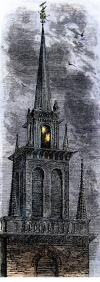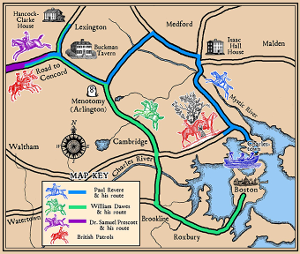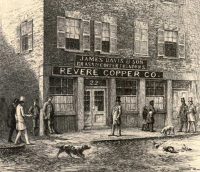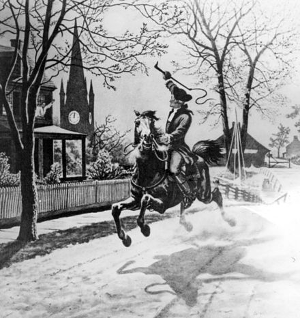Revere did not own a horse. He borrowed one, from John Larkin. Some sources say that this horse had a name, Brown Beauty. 
The North End Christ Church played a part in this famous episode. A man was to give a signal by shining one or two lanterns in the church tower, depending on how the British troops were going to leave Boston. One lantern meant that the troops would be marching overland, out Boston Neck; two lanterns meant a sea transport across the Charles River to Cambridge. Revere, having been told of two lanterns in the church tower, set off for Lexington about 11 p.m. He evaded British troops outside Charlestown and then rode through Medford, to alert the local militia captain, Isaac Hall. He rode on, through what is now Somerville, Medford, and Arlington, reaching Lexington and delivering his message to Hancock personally. 
Another rider, with the same intent, arrived in Lexington. This was William Dawes. He and Revere resolved to continue on to Concord, to make sure that the militiamen there had hidden their stash of weapons. Not long after they left Lexington, another rider, Dr. Samuel Prescott, caught up to them. The three rode on toward Concord. They eventually ran into a British patrol. In the resulting confusion, Dawes and Prescott escaped but Revere did not. He faced several intense minutes of questioning but was eventually let go, without his horse. (A British sergeant claimed it in order to replace his tired mount.) Revere walked back to Lexington and arrived just in time to see the end of the battle on Lexington Green. Prescott made it to Concord, where he lived, and alerted the militia there. Dawes fell of his horse in the dark and did not make it to Concord. Revere did fight in the war. He was in the artillery on the Penobscot Expedition to Castine, Maine, that ended in disaster. He left military service soon thereafter. He also embarked on a mission at the behest of the Massachusetts provincial congress to study the powder mill in Philadelphia, in hopes of building one closer to home. He saw enough to have one built in Stoughton, what is now Canton. Joseph Warren, who had tasked Revere with his famous ride and who was a good friend, died in the Battle of Bunker Hill and was buried in an unmarked grave. Revere went back later and, identifying his friend by the false tooth he had placed there in his role as a part-time dentist, enabled Warren to have a proper funeral and a marked grave. 
Revere ran a hardware store after the Revolutionary War. In 1788, he had opened a foundry to make bolts, nails, spikes, cannons, and bells for the Boston shipyards. He turned his copper skills to rolling and sheeting, opening the first copper rolling mill on the continent, in 1801. Among his contributions were copper sheeting for the hull of "Old Ironside," the famous ship the U.S.S. Constitution. Revere retired at age 76, in 1811. He left his copper business to his sons and grandsons. He died on May 10, 1818, when he was 83. The famous Henry Wadsworth Longfellow poem "Paul Revere's Ride" was first published in 1861. Although some of the details of the poem are not accurate, the popularity of the poem made Revere into a legend. First page > Arms and Crafts > Page 1, 2 |
|
Social Studies for Kids
copyright 2002–2025
David White

 It was on the night of April 18, 1775, that Revere made his famous ride to warn of an advance by British troops. (He had already ridden to Concord just days before, to warn the provincial congress of British troop movements.) Dr. Joseph Warren of Boston again tasked Revere with riding to Lexington to alert
It was on the night of April 18, 1775, that Revere made his famous ride to warn of an advance by British troops. (He had already ridden to Concord just days before, to warn the provincial congress of British troop movements.) Dr. Joseph Warren of Boston again tasked Revere with riding to Lexington to alert 
